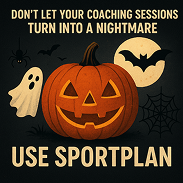
Team plays keep away 4v1 in the small grid. If attacking team completes 7 passes (tip: start with more and progress to less in order to increase the frequency of the 4v3+1 attack) they may attack the small targets beside the opposing team's grid. (4v3+1 recovering) If the lone defender wins the ball he tries to get the ball to his teammates in the opposite grid while being trailed by one player from the opposing team. As soon as the ball gets there they begin playing 4v1.
body position (able to see the pass coming, where the pass is going while keeping all options available: pass dribble shoot) Scanning (can the player identifiy the next play as the ball travels reducing the time needed on the ball and increasing the pace of play.)
This practice has no coaching points
This practice has no progressions

Save yourself a scare this Halloween and ensure your session runs smoothly. No chaos, no fright, just structure.

As the Lions tour approaches with their first tour game this Friday against Argentina, we look ahead at what the fans can expect to see from both sides as the tour in Australia approaches...

Introducing the Sportplan FootballBot. Your new coaching partner that has all the answers to the questions you may have...